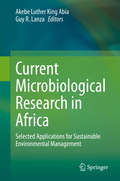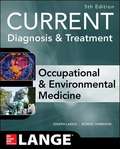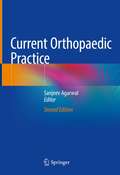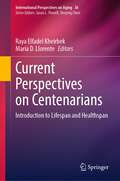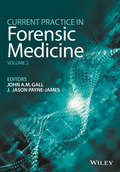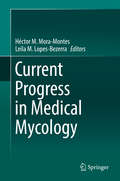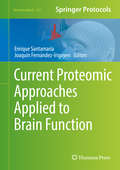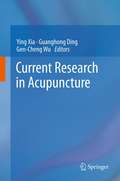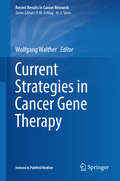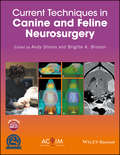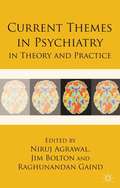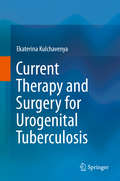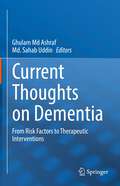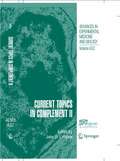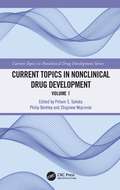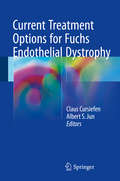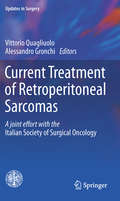- Table View
- List View
Current Medical Diagnosis and Treatment 2021
by Michael W. Rabow Stephen J. McPhee Maxine A. PapadakisCurrent Medical Diagnosis & Treatment 2021 (CMDT 2021) is the 60th edition of this single-source reference for practitioners in both hospital and ambulatory settings. The book emphasizes the practical features of clinical diagnosis and patient management in all fields of internal medicine and in specialties of interest to primary care practitioners and to subspecialists who provide general care.
Current Microbiological Research in Africa: Selected Applications for Sustainable Environmental Management
by Guy R. Lanza Akebe Luther King AbiaScientific output in low- and middle-income countries is greatly challenged by numerous factors. This is particularly pronounced in sub-Saharan African countries, despite the continent being the world’s second largest and second most-populous continent, currently undergoing rapid economic growth. Financial constraints and unclear areas of focus when funding is available, are among the limiting factors, with the consequence being the development of inadequate policies, especially those relating to environmental protection and conservation.This 13-chapter book is a unique piece in the field of microbiology, designed to stimulate some research areas in Africa by illustrating interesting and informative examples of the current applied research agenda in environmental microbiology in selected countries within the continent. With authors from the North, South, East and West of Africa, the book touches diverse applied methods and approaches to meet the pragmatic needs faced by environmental microbiologists in Africa. Also included are topics on viruses, bacteria (including cyanobacteria), and protozoa, and their importance in disease. Sustainable agriculture and aquaculture, and eco-friendly oil and hydrocarbon bioremediation and degradation approaches are highlighted. Microbial involvement in different common indoor (e.g., household kitchens, latrines, and hospitals) and outdoor settings including air, soil, and water habitats, and their resistance to commonly used antibiotics, are described. Hopefully, the work presented here will stimulate the need for increasing modern training and funding initiatives to prepare African microbiologists to meet the challenges they face in African universities and research laboratories.
Current Occupational and Environmental Medicine 5/E (Lange Medical Books)
by Robert Harrison Joseph LaDouA thorough, concise, up-to-date guide to the diagnosis and treatment of common occupational and environmental injuries and diseases <P><P>A Doody's Core Title for 2017! <P><P>Coverage includes: <ul> <li>Chapters on how to conduct an occupational and environmental medical history, examine the patient, evaluate exposures, and prevent further injury and illness</li> <li>New methods of disability management and the important role that physicians can play in preventing disability</li> <li>Practical information on the toxic properties and clinical manifestation of common industrial materials</li> <li>Techniques to prevent acute and cumulative workplace-related injuries</li> <li>Detailed discussion of international occupational and environmental health, and issues of worker migration</li> <li>An appendix that concisely introduces the important topics of biostatistics and epidemiology</li> </ul> <P><P>LANGE The definitive overview of common occupational and environmental illnesses <P><P>NEW CHAPTERS on electronic health records, the management of chronic pain, violence in the workplace, terrorism preparedness, disease surveillance, and chemical policy <P><P>Valuable to practicing physicians as well as students and residents
Current Orthopaedic Practice
by Sanjeev AgarwalThe book is intended as the second edition of previously published ‘Current Orthopaedic Practice’. The book is a unique publication from the UK, which covers the entire clinical orthopaedic spectrum. The FRCS exam is an end-of-training examination for Orthopaedic trainees in the UK. There is a paucity of textbooks published in the UK which cover the spectrum of knowledge required. The updated edition builds on the success of the first edition. This book is divided into 18 chapters, which cover the entire remit of clinical orthopaedics. The chapter on sports injuries has been split into two chapters - disorders of the hip and disorders of the knee. A unique feature which has been retained is the incorporation of annotated bibliography within the text. The list of references has been provided as 'further reading suggestions' at the end of the chapter. The annotated text within the chapter helps the reader to understand the study design and key message from the article. The articles selected for inclusion in the text are seminal articles, or recent articles which have led to change in practice. The line drawings are simple and easy to reproduce. Classifications are presented pictorially as much as possible, instead of tables, and this helps memorisation. This book is an essential resource for all orthopaedic graduates, trainees and professionals alike.
Current Perspectives on Centenarians: Introduction to Lifespan and Healthspan (International Perspectives on Aging #36)
by Maria D. Llorente Raya Elfadel KheirbekThis book explores various aspects related to human longevity and aging beyond 100 years old. It examines all domains of health and well-being of this elite group including the current demographics, genetics and epigenetics of exceptional longevity, cardiovascular risk factors, dementia, nutrition, physical activity, African American and Hispanic centenarians, financial planning, religion, spirituality, whole health, wellness, oral health, and nature. The book also delves into the lives of supercentenarians, defined as expert survivors who have lived beyond 110 years old. The implications of the Age-Friendly Healthcare Systems (AFHS) Movement on the care of centenarians are also discussed. This book is a valuable resource for healthcare professionals, epidemiologists, public health professionals, policy makers, and anyone interested in the study of aging and longevity.
Current Practice in Forensic Medicine
by Jason Payne-James John GallAlthough forensic medicine has been in existence for centuries in one guise or another, it is only with the recent growth in international research that it has begun to be acknowledged as a specific discipline in its own right. Many areas of progress are being made and this text aims to provide a unique, in-depth and critical update on selected topics that are of direct relevance to those practicing in the field including lawyers, police, medical and dental practitioners, forensic scientists and postgraduate/undergraduate medical students and undergraduate law students preparing for forensic medicine examinations.This volume is designed to cover the wider aspects of forensic medicine, including the law, science, medicine (forensic pathology, clinical forensic medicine and forensic psychiatry) and dentistry. Topics covered include subjects of debate and/or uncertainty in areas where significant advances have been made and in those of current relevance to the forensic profession, Chapters provide a variety of approaches to the areas under discussion with reviews of current knowledge, information on significant changes and pointers to the future that the reader should be aware of.Features:An authoritative review, for forensic medicine practitioners throughout the world, from leading international experts in the field.Provides critical commentary and updates on current practice.Topics include: a guide to the presentation of forensic medical evidence, bioterrorism, the paediatric hymen, assessment and interpretation of bone trauma in children, adult sexual assault, genital photography, forensic photography, common errors in injury interpretation, self-inflicted injuries and associated psychological profiles, bite marks and the role of the pathologist in aviation disasters.Includes a wealth of four colour figures to illustrate key points discussed within the text.
Current Practice in Forensic Medicine
by Jason Payne-James John A. GallForensic medicine is a broad and evolving field with areas of rapid progress embracing both clinical and pathological aspects of practice, in which there may be considerable overlap. This is the second volume in a series that provides a unique, in-depth and critical update on selected topics of direct relevance to those practising in the field of clinical forensic medicine and related areas including lawyers, police, medical practitioners, forensic scientists, and students. The chapters endeavour to maintain a relevance to an international, multi-professional audience andinclude chapters on: DNA decontamination, The toxicity of novel psychoactive substances, The relevance of gastric contents in the timing of death, The effects of controlled energy devices, The main risk factors for driving impairment, The risk factors for harm to health of detainees in short-term custody, Autoerotic deaths, Child maltreatment and neglect, and The investigation of potential non-accidental head injury in children. Also included are chapters on excited delirium syndrome, automatism and personality disorders. Two topics not generally covered in standard clinical forensic medical textbooks include a forensic anthropological approach to body recovery in potential crimes against humanity and risk management and security issues for the forensic practitioner investigating potential crimes against humanity in a foreign country.
Current Practice in Forensic Medicine, Volume 3
by John A.M. Gall J. Jason Payne-JamesCURRENT PRACTICE in Forensic Medicine Presents a unique overview and critical commentary on the latest developments in forensic medical practice worldwide The field of forensic medicine continues to evolve worldwide. In recent years, the amount of research has increased and new areas of forensic specialization have developed. Forensic practitioners need to keep pace with a range of international advances from innovative technologies to new or revised laws and regulations to emerging issues of controversy. Current Practice in Forensic Medicine, Volume 3 provides an in-depth examination of key areas of the field. This timely and comprehensive resource addresses consent for forensic procedures, imaging for soft tissue injuries, working with victims of torture, non-accidental injury in the elderly, medical and toxicological aspects of chemical warfare, non-fatal strangulation, abusive head trauma in young children, and more. Each chapter contains a general overview of the area under discussion, references to published literature, and detailed discussion of significant changes and key points. Offers new insights into false allegations of sexual assault, coercive control and the homicide timeline in partner abuse cases, and the needs of elderly persons in detention Provides non-country specific information to guide international forensic medicine practitioners and healthcare professionals Contains detailed yet concise chapters written by authors with particular expertise in the subject covered Addresses the clinical and pathological aspects of forensic medicine and relevant areas in toxicology, forensic psychiatry and psychology, and forensic biology Covers riot control weapons, chemical warfare, non-fatal strangulation, DNA in crime detection, and many other essential topics Includes up-to-date information on the new Medical Examiner system in England and Wales Supported by the most recent evidence-based research, Current Practice in Forensic Medicine, Volume 3 is a must-have for all those involved in various aspects of forensic medicine including doctors, dentists, forensic scientists, lawyers, law enforcement professionals, and forensic practitioners.
Current Practice of Clinical Electroencephalography
by Aatif M. HusainReadable, concise, and data-driven, Current Practice of Clinical Electroencephalography, 5th Edition, delivers a comprehensive overview of the dynamic field of EEG. Dr. Aatif M. Husain leads a team of internationally recognized authors who provide updates on established areas of clinical EEG, discuss newly evolving areas, and explain neurophysiological basis of pathology to encourage understanding rather than simply pattern recognition. Now in full color throughout, it’s a must-have resource for residents, neurologists, clinical neurophysiologists, epilepsy specialists, electroneurodiagnostic technologists and practicing electroencephalographers, as well as students, trainees, and researchers—anyone who desires to stay up to date and use EEG to its fullest potential.
Current Procedural Terminology, HCPCS, and Procedural Coding for Professionals and Physicians
by Kimberly HueyThis textbook provides basic training and practice in the application of procedural codes from the Current Procedural Terminology (CPT) and the Healthcare Common Procedure Coding System (HCPCS). CPT is published by the American Medical Association (AMA). Updated annually on January 1, CPT is a proprietary terminology created and maintained by the AMA. Its purpose is to provide a uniform language for describing and reporting the professional services performed by physicians. HCPCS is maintained by the Centers for Medicare and Medicaid Services (CMS). Its purpose is to provide a system for reporting the medical services received by Medicare beneficiaries. HCPCS is made up of two parts: Level I is composed entirely of the current version of CPT; HCPCS Level II provides codes to represent medical services that are not covered by the CPT system, such as medical supplies and services performed by healthcare professionals who are not physicians.
Current Progress in Medical Mycology
by Héctor M. Mora-Montes Leila M. Lopes-BezerraInfections caused by fungi have recently attracted the attention of both clinicians and basic researchers given the heavy burden they represent for any health system. The mortality and morbidity rates associated to mycosis are progressively rising simply because some of these diseases are still neglected by health-care workers and due to the changing sensitivity to antifungal drugs displayed by these organisms. In this book, both researchers and clinicians working in the medical mycology field explore the most recent literature about specific mycosis; placing in one concise chapter thoroughly revisions of the current knowledge on virulence factors, recognition by immune cells, immunoevasion, epidemiology, new diagnosis trends and therapeutics. This book is recommended to researchers, physicians and students interested in medical mycology.
Current Proteomic Approaches Applied to Brain Function
by Enrique Santamaría Joaquín Fernández-IrigoyenThis volume focuses on protein analysis covering a wide spectrum of the utility of mass spectrometry within neurobiological disciplines. The chapters in this book discuss label (iTRAQ, TMT, protein arrays) and label-free workflows (SWATH, MALDI Imaging, and label-free quantitation). Other chapters look at experimental strategies targeted to the identification and quantitation of specific lipids and post-translational modifications, as well as proteomic workflows that focus on characterization of subcellular proteomes. The last few chapters in the book describe various bioinformatics pipelines used to analyze the molecular data derived from high-throughput transcriptomic and proteomic experiments on brain tissue. The Neuromethods series offers chapters with key advice and procedure specifics to empower the readers to successfully achieve their own scientific and experimental goals.Thorough and comprehensive, Current Proteomic Approaches Applied to Brain Function is a valuable resource for graduate students and postdoctoral fellows interested in neuroproteomics, as well as researchers looking for further insight into the growing field of mass spectrometry in neuroscience.
Current Research in Acupuncture
by Ying Xia Guanghong Ding Gen-Cheng WuWritten by over 60 scientists and clincicians from the United States, mainland China, Germany, Australia, Japan, Sweden, Portugal and Hong Kong, Current Research in Acupuncture discusses recent advances in acupuncture research in a modern scientific language. The first 5 chapters investigate the basic mechanisms of acupuncture. Later chapters explore topics including acupuncture treatment and potential mechanisms for epilepsy, Parkinson's diseases, neurodegenerative disorders such as Alzheimer's disease, vascular cognitive impairment, aging, anxiety, polycystic ovary syndrome, pain, nerve root cervical spondylosis, stroke, imflamation, myocardial ischemia and other cardiovascular diseases. Following the translational and clinical discussions, 4 chapters present new prospects for acupuncture theories and applications. The final chapter comments on the pitfalls and problems of the previous studies and suggests direction for future research towards in-depth understanding of acupuncture, along with better application of acupuncture in modern medicine. Each chapter is written by one or more experts in the field. This unique book provides a broad perspective on the principles of acupuncture for acupuncture researchers and neuroscientists. The laboratory and clinical investigations of various acupoints and optimal conditions provide unique clues to acupuncturists for improved clinical efficacy. For a medical student, this book is a modern course in ancient Traditional Chinese Medicine, especially acupuncture. Ying Xia, the chief editor, is Professor and Vice-Chairman of the Department of Neurosurgery at The University of Texas Medical School in Houston, Texas, USA. Guanghong Ding is Professor in the Department of Mechanics and Engineering Science at Fudan University and Director of Shanghai Research Center for Acupuncture and Meridians, Shanghai, China. Gen-Cheng Wu is Professor of Neurobiology; Chairman, Department of Integrative Medicine and Neurobiology; Director, Institute of Acupuncture Research; and Director, WHO Collaborating Center for Traditional Medicine, at Shanghai Medical College of Fudan University, Shanghai, China.
Current Rhinology
by Samy ElwanyThe book provides a combination of clinical and academic information for rhinologists, otolaryngologists, and postgraduate students. It covers a wide range of topics, including important related areas such as the orbit, skull base, and the teeth. Additionally, it addresses recent hot topics like multiplanar reconstruction, biologics, image guided surgery, 3D endoscopy, and endoscopic transorbital surgery. Furthermore, six chapters are dedicated to rhinoplasty, and two chapters focus on nasal and maxillofacial trauma. The book encompasses the basic sciences of rhinology, investigative rhinology, rhinologic symptoms and diseases, as well as office procedures and operations. For instance, in the chapter on olfaction, topics such as the physiology, pathophysiology, and disorders related to olfaction are covered. Similarly, when discussing the nasal septum and valves, the authors explore the dynamics of the nasal airway. The book has been written by an array of distinguished rhinology experts from several countries and with different subspeciality interests. All topics are presented in a concise and easily understandable manner and are supported by explanatory pictures, illustrations, video clips, ensuring that the book serves as a resource on fundamental aspects of rhinology as well as a reference guide for the recent advancements in the field.
Current Strategies in Cancer Gene Therapy (Recent Results in Cancer Research #209)
by Wolfgang WaltherThis book describes important developments and emerging trends in experimental and clinical cancer gene therapy. It reflects the tremendous advances made over recent years with respect to immunogenes, suicide genes and gene correction therapies, as well as in gene suppression and miRNA therapies. Many of the described strategies focus on the generation of more efficient and specific means of attack at known and novel cellular targets associated with tumor development and progression. The book also details parallel improvements in vector design, vector delivery, and therapeutic efficacy. It offers readers a stimulating, broad overview of advances in the field, linking experimental strategies to their clinical applications.
Current Techniques in Canine and Feline Neurosurgery
by Andy Shores Brigitte A. BrissonCurrent Techniques in Canine and Feline Neurosurgery offers state-of-the-art, detailed guidance on performing neurosurgical techniques in dogs and cats, from indications and surgical anatomy to procedures and post-operative care. Presents an up-to-date, detailed reference on veterinary neurosurgery techniques, covering skills ranging from basic to advanced Provides guidance on why, when, and how to perform neurosurgical procedures Includes information on diagnostic evaluation, surgical planning, and instrumentation as well as step-by-step descriptions of specific procedures Copublished with the American College of Veterinary Surgeons Foundation and American College of Veterinary Internal Medicine Offers video clips on a companion website
Current Themes in Psychiatry in Theory and Practice
by Niruj Agrawal Jim Bolton Raghunandan GaindAn up-to-date overview of a range of topics, covering contemporary concerns and therapeutic challenges in clinical psychiatry, written by distinguished psychiatrists who are leaders in their fields. This volume will help to shape the clinical practice of psychiatry students and mental health professionals.
Current Therapy and Surgery for Urogenital Tuberculosis
by Ekaterina KulchavenyaThis book is written by a high-skilled specialist with huge experience in diagnosis, therapy and surgery for urogenital tuberculosis UGTB is the second most common form of TB in countries with a severe epidemic situation and the third most common form in regions with low incidence of TB. With patients living in the region of a high TB incidence rate or patients who had contact with TB or suffer from recurrent course of the disease, all urogenital tract infections should be tested for UGTB. Patients with tuberculosis, including UGTB need long multi-drug chemotherapy, and compliance depends on the drug tolerance. Anti-TB therapy for kidney TB was complicated by adverse effects in 41. 0%. This book discovers ways of minimizing side effects and presents optimal regimens and surgical techniques for UGTB patients.
Current Therapy in Endodontics
by Priyanka JainDentistry has been undergoing enormous changes, and the field of endodontics has certainly been at the forefront. Recent advances in technology, materials, and equipment have changed the way endodontics is practiced today, thereby facilitating treatments with greater efficiency, precision, and success, ultimately leading to better outcomes. Current Therapy in Endodontics encompasses the recent discoveries and applications for this field in one clinically relevant volume. Evidence-based presentation of recent advances in the field of endodontics Objective comparison of materials and instruments on the market Tables present key data and instruction for quick viewing and comprehension
Current Thoughts on Dementia: From Risk Factors to Therapeutic Interventions
by Ghulam Md Ashraf Md. Sahab UddinThis informative book discusses the latest research on the risk factors and therapeutics in dementia. WHO calls dementia a public health priority. Dementia manifests as a group of symptoms associated with decline in memory or other thinking skills and is severe enough to reduce a person's ability to perform everyday activities. It occurs frequently among elderly people, but it is not necessarily part of the normal aging process. The book has been divided into two broad sections. The first section reviews the risk factors involved in developing dementia, including various medical conditions, lifestyle choices, as well as genetics. The latter section describes various therapeutic interventions in dementia. Although there is no known cure for dementia, this book underlines the current treatment strategies that could momentarily reduce the symptoms and improve the quality of life of the patients. This book highlights the global effort to find better ways to halt the progression of dementia and develop novel therapeutic strategies. The book would be an interesting read for advanced graduate students and researchers working in the field of neuroscience, genetics, and medicine. It will generate good interest to neurologists, psychiatrists, geriatricians, cardiologists, internal medicine practitioners, epidemiologist, and public health workers.
Current Topics in Complement II (Advances in Experimental Medicine and Biology #632)
by John D. LambrisComplement has long been regarded as a pivotal effector arm of the innate immune response, eliciting important immunoregulatory functions in the context of inflammation and also serving as a vital link between the innate and adaptive immune response. In the post-genomic era, our knowledge of the innate immune system is enriched by findings that point to novel functions that do not strictly correlate with immunological defense and surveillance, immune modulation or Inflammation. Several studies indicate that complement proteins exert functions that are either more complex than previously thought, or go well beyond the innate immune character of the system. The advent of high-throughput platforms for genome and proteome-wide profiling, together with the enormous amount of raw genetic information that has accumulated in the databases, have stirred new expectations in biomedical research. They have led complementologists to revisit established biological systems, such as the complement system, from a global and integrative perspective. Complement research is now faced with the challenge of trying to integrate isolated biochemical pathways into complex gene and protein regulatory circuits. In this respect, scientists from around the world convened at the Fourth Aegean Conferences Workshop on Complement Associated Diseases, Animal Models, and Therapeutics (June 10-15, 2007), to discuss recent advances in this fast evolving field. This volume represents a collection of topics on the "novel" functions of complement, patho-physiology, protein structures, design of complement inhibitors, and complement assays discussed during the conference.
Current Topics in Innate Immunity II (Advances in Experimental Medicine and Biology #946)
by John D. Lambris George HajishengallisMounting evidence in the past decade indicates that innate immunity mediates functions above and beyond first-line defense against infection. It is now appreciated that innate immune mechanisms are critically involved in the development of adaptive immunity and, moreover, the regulation of diverse physiological and homeostatic processes. The latter explains why deregulation of innate immunity may lead to pathological disorders that are not necessarily or directly related to host defense. This Volume compiles the latest advances in this rapidly evolving field as presented by eminent scientists at the 7th International Aegean Conference on Innate Immunity in Rhodes, Greece. It includes topics related to the biology and function of Toll-like and other pattern-recognition receptors, complement and its crosstalk with other physiological systems, inflammatory mechanisms and diseases, natural killer cells, and the cooperative interplay between innate and adaptive immune cells. This book is an excellent source of information for researchers and clinicians with interests in immunology, host-microbe interactions, and infectious and inflammatory diseases.
Current Topics in Nonclinical Drug Development: Volume 1 (Current Topics in Nonclinical Drug Development Series)
by Pritam S. Sahota Philip Bentley Zbigniew WojcinskiThe inaugural volume in the Current Topics in Nonclinical Drug Development Series explores the critical issues and current topics in nonclinical drug development. This first volume covers individual topics and strategies in drug development from compound characterization to drug registration. Written by a variety of experts in the field, recent and rapid advances in technologies and associated changes in regulatory guidance are discussed. Additional features include: Deals with day-to-day issues in study design, evaluation of findings, and presentation of data. Explains new approaches in the development of medical devices. Includes dedicated chapters on the use of bioinformatics in drug development. Addresses strategies for photosafety testing of drugs. Current Topics in Nonclinical Drug Development, Volume I will aid toxicologists, toxicologic pathologists, consultants, regulators, Study Directors, and nonclinical scientists dealing with day-to-day issues in study design, evaluation of findings, and presentation of data. In addition, the book will be a valuable reference for academicians and graduate students pursuing research related to nonclinical drug development.
Current Treatment Options for Fuchs Endothelial Dystrophy
by Claus Cursiefen Albert S. JunThis book provides state of the art information on modern minimally invasive lamellar transplant techniques for Fuchs endothelial dystrophy (FED), such as Descemet stripping automated endothelial keratoplasty (DSAEK) and Descemet membrane endothelial keratoplasty (DMEK). In addition to clear step-by-step descriptions of procedures, guidance is offered on donor tissue preparation, potential intra- and postoperative complications, and complication management. Future treatment options in the form of medical, cell-based approaches are also discussed. To complete the picture, relevant information is included on the pathophysiology, clinical features, and differential diagnosis of FED. This book will be of interest to all who wish to learn about the dramatic developments in corneal transplantation and medical treatment that are transforming the management of FED.
Current Treatment of Retroperitoneal Sarcomas (Updates in Surgery)
by Vittorio Quagliuolo Alessandro GronchiThis book provides a comprehensive overview of the approach to retroperitoneal sarcomas, rare and challenging tumors requiring highly specialized, multidisciplinary management. Based on an updated review of the literature and drawing on the expertise of respected authors, it analyzes key topics – such as pre-operative work-up and staging, multimodal therapy, multi-organ resection, surgical complications and management of local recurrence and advanced disease – as well as several other debated issues. Presenting surgery as the cornerstone in the treatment of this disease, the book serves both as a guide for non-expert physicians wishing to understand the best management of RPS patients, including the need to refer them to specialized centers, and as a state-of-the-art overview for surgeons with interest in sarcoma surgery.

